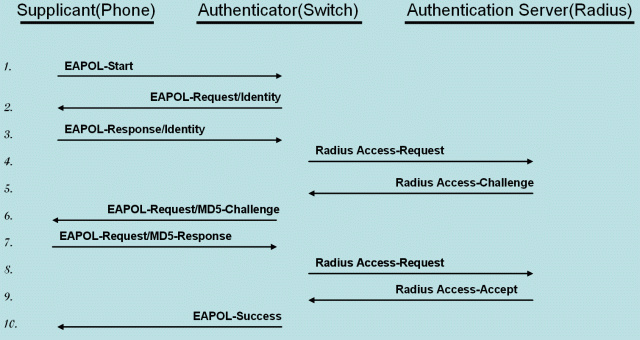Reference9:Interfaces/ETH/802.1X
Jump to navigation
Jump to search
There are also other versions of this article available:
Reference7 | Reference9 (this version) | Reference11r1 | Reference11r2
802.1X, Port-Based Network Control, is an IEEE standard. The standard allows LAN devices (wired network cabling![1]) to perform an authentication handshake within the 802.3 link layer (Ethernet). The authentication is encapsulated within EAP over LAN (EAPOL) frames. No other traffic, except EAPOL is allowed prior to a successful authentication[2][3].
The standard specifies the following parties participating in an 802.1X authentication:
- Supplicant: The party supplying credentials towards an authenticator on the other side of a point-to-point link. An IP phone fulfills a supplicant's role.
- innovaphones' IP phones are configured to support pass-through of EAPOL messages. A PC attached to the PC-port of a phone may also become a supplicant and may 802.1X-authenticate independently and separately[4].
- Authenticator: The party facilitating the authentication. A switch will usually be the authenticator.
- Authentication Server: The party providing the authentication service to the authenticator. The 802.1X standard mentions a RADIUS server to be an authentication server.
Sample Protocol Flow:
An 802.1X EAP-MD5[5] authentication handshake[6].
EAP-MD5:
- User: Enter the user/identity to authenticate with.
- Password: Enter the shared secret for the MD5 challenge/response handshake.
Notes
- ↑ The standard refers to 802 LANs as a whole, including shared media such as 802.11 WLANs. However, only 802.3 LANs are targeted by the functionality discussed in this article.
- ↑ It is an authenticator's task to guarantee that non-EAPOL traffic won't be forwarded before an authentication succeeded.
- ↑ 802.1X must not be considered a bullet-proof security mechanism, since all traffic following the authentication phase is not authenticated.
- ↑ Major authenticators do support multi-host authentication
- ↑ innovaphone devices support the EAP-MD5 authentication handshake.
- ↑ Message 9 within the sample protocol flow from above does often piggy-back additional RADIUS attributes with the intent to configure VLAN parameters at the authenticator/switch device. 802.1x thereby allows for user-related VLAN configuration at the authenticator/switch.
